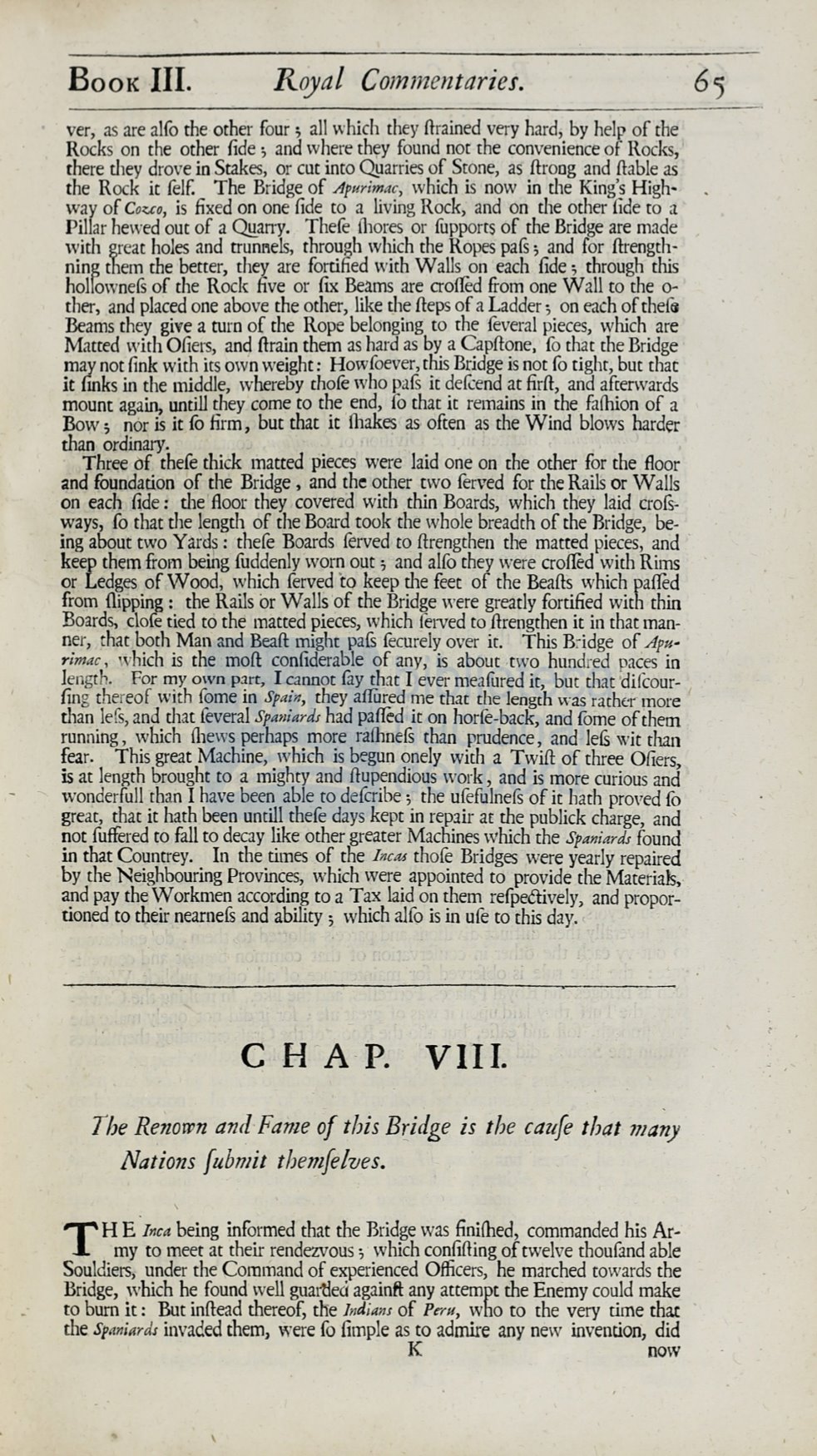

BooK
III.
Royal Commentaries.
ver, as are alfo the other four; ali which they firained very hard, by help of the
Rocks on the other fide ; and where thyy found nor che convenience of Rocks, ·
there rhey drove
in
Stakes, or cut into Qiarries of Srone, as íl:roog and fiable as
the Rock ir felf. The Bridge of
Apurimac,
which is now in che King's High·
way of
Cow,
is fixed on one fide
to
a living Rock, and on che ocher fide to a
Pillar hewed out of a Qg_an-y. Thefe íhores or fupports of che Bridge are made
wich great hales and trun!'lels, through which che Rapes país; and for íl:rengch–
ning them che better, rhey are fortified with Walls on each fide; through chis
hollowneís of che Rock five or fix Beams are croffed from one Wall
co
che o–
ther, and placed one above che other, like che íl:eps of aLadder; on each ofchefa
Bearns they give a tura of che Rope belongiog
co
che feveral pieces, which are
Matred with Ofiers, and füain them as hard as by a Capíl:one,
fo
rhat the Bridge
may noc fink with its own weight: Howfoever, chis Bridge is not
fo
tight, bue that
it
finks in che middle, whereby chofe who país it defcend ar firíl:, and afcerwards
mount again, untill they come to the end,
fo
that ic remains
in
the fafhion of a
Bow ; nor is it
fo
firm, bue that ic fhakes as,ofcen as che Wind blows harder
than ordinary.
Three
of
thefe thick matted pieces were laid one on che ocher for che floor
and foundation of che Bridge , and che other cwo ferved for che Rails or Walls
on each fide : che'floor they covered with chin Boards, which chey láid crofs-–
ways,
fo
that the lengch of che Board took che whole breadch of che Bridge, be–
ing about two Yards : chefe Boards ferved
to
íl:rengthen the rnac~ed pieces, and ·
keep them from beihg fuddenly worn out ; and alfo rhey were crolfed with Rims
or Ledges of Wood, which ferved i:o keep che feet of che Beaíl:s which paffed
from ílipping : che Rails or Walis ·of che Bridge were great!y forcified with thin
Boards, clofe tied ro the matted pieces, which ferved to ,firengchen ic in chat man–
ner, that both Man and Beaíl: mighc pa[s fecurely over ir. This Bddge of
Apu–
rimac ,
vhich is che moíl: coníiderable of any, is abouc ,two hundred paces in
length.
For
my
own part, I cannoc
fay char I ever meafured it, bue that 'diícour–
fing thereof with fome in
Spain,
rhey affured me chat
the lengch
was rather more
1
than Iers, and chat feveral
Spaniard1
had palfed it on horfe-back, and fome ofthem
running, which íhews perhaps more raíhneís than prudence, and lels wit rhan
fear.
This great Machine, which is begun onely wich a Twiíl: of three Ofiers,
is
ar length brought to a mighcy and íl:upendious work, and
is
more curious and
wonderfull than I have been able
to
de[cribe ; che ufefulneís of ic harh proved fo
greac, thac it hath been uncill thefe days kepr in repair at the publick charge, and
not fuffered to fall to decay like ocher greater Machines which che
Spaniards
found
in that Countrey.
In
che times of ene
Inca.
chofe Bridges were yearly repaired
by che Neighbouring Provinces, which were appointed to provide che Matetial's,·
and pay che Workmen according to a Tax laid on rhern refpefüvely, and propor–
tioned to their nearnefs and ability ; which alfo is in ufe to th!s day.
CH A -P.
VIII.
The Renown and-Fame of this Bridge is the caufe that many
Nations
fubmit
themfelves.
T
HE
·Inca
being informed that che Bridge was finiíhed, commanded bis Ar–
my to meer ac their rendezvous ; which confifüng ofcwelve rhoufand able
Souldiers, under che Command of experienced Officers, he marched rowards che
Bridge, ~vhich h~ found well guartieci a~ainft any attempt the Enemy co~ld make
to bum 1t : Bue míl:ead thereof, che
Jndians
of
Peru,
who to che very ame rhac
the
Spaniards
invaded them, were
fo
!imple as to admire any new invention, did
K
now














